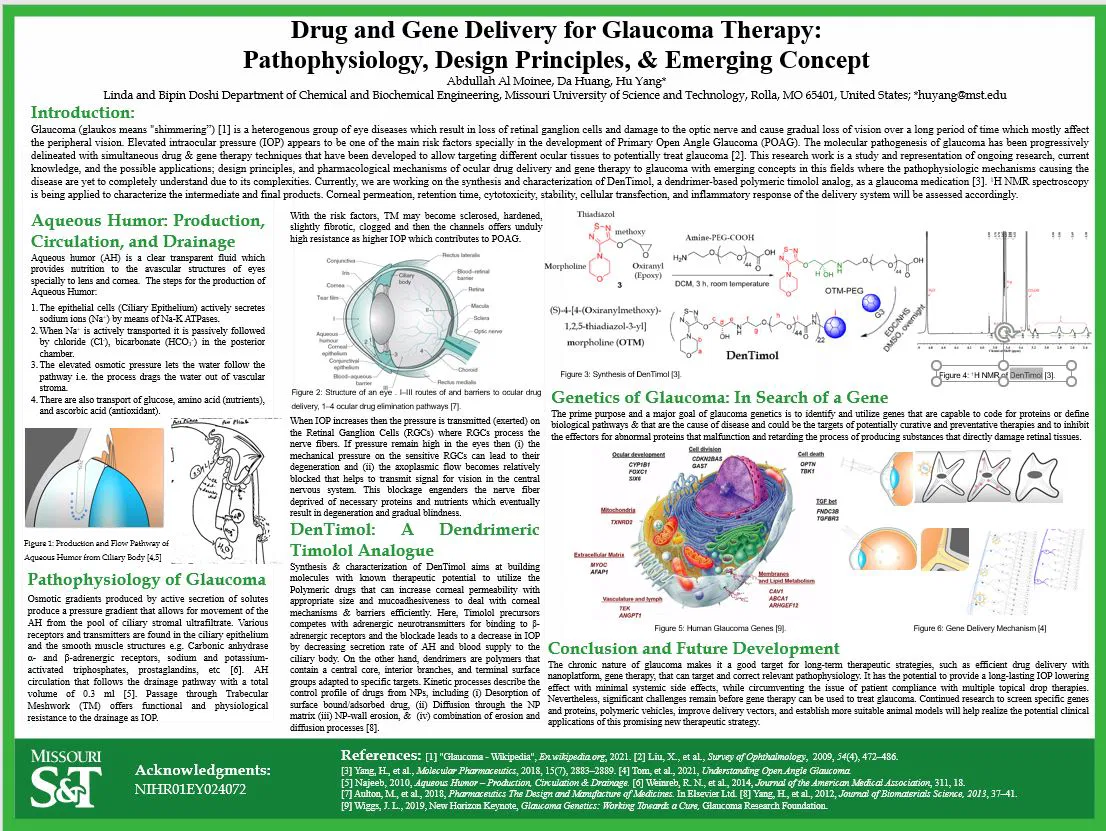Graduate Student Research
- Research Outline:
Investigation on the role & mecanisms of Biomaterials and Nanotechnology in the treatment of Ocular Diseases (Glaucomas) as well as their applications in Biomanufacture, Tissue engineering, Pharmaceutical Engineering, Drug & Gene delivery
Abstract:
Glaucoma (glaukos means "shimmering” [1]) is a heterogenous group [2] of eye diseases which result in loss of retinal ganglion cell [3] and damage to the optic nerve (or retina [4]) and cause gradual loss of vision over a long period of time which mostly affect the peripheral vision. It is the second most frequent cause of irreversible blindness and visual impairment worldwide and is becoming increasingly prevalent as life expectancy increases [5-6]. Glaucoma affects more than 70 million people worldwide with approximately 10% being bilaterally blind [4] making it the leading cause of irreversible blindness in the world. The disease can remain asymptomatic until it is severe, resulting in a high likelihood that the number of affected individuals is much higher than the number known to have it [5-7]. Elevated intraocular pressure (IOP) appears to be one of the main risk factors specially in the development Primary Open Angle Glaucoma (POAG) [3]. Progression usually stops if the intraocular pressure is lowered by 30–50% from baseline [2]. At present, there is no treatment that reverses the glaucomatous optic neuropathy that characterizes this disease. The prime purpose in the treatment and management of glaucoma is to lower the IOP. Topical drops are the most common and first treatment option for elevated IOP. Once a patient is diagnosed with glaucoma, they remain a glaucoma patient and may need to be treated for the rest of their life, often with more than one therapy [9] where patient compliance may be problematic in the long term. Besides, surgical therapies carry certain risks and may not free patients from the need for additive topical therapies though they can slow progression of the disease by treating ocular hypertension to lower IOP by a few mm Hg. The molecular pathogenesis of glaucoma has been progressively delineated and simultaneous drug and gene therapy techniques have been developed and refined to allow targeting different ocular tissues to potentially treat glaucoma [5,9]. This research work is a study and representation of ongoing research, current knowledge, and the possible applications; design principles, and pharmacological mechanisms of ocular drug delivery and gene therapy to glaucoma with emerging concepts in this fields. Besides, animal models are being studied to explore the strengths and limitations associated with each species use, and some potential criteria to develop a suitable model by considering the substantial field [3] of glaucoma where the pathophysiologic mechanisms causing the disease are yet to completely understand due to its complexities. In this work, we are working on the synthesis and characterization of DenTimol, a dendrimer-based polymeric timolol analog, as a glaucoma medication [10]. 1H NMR spectroscopy is being applied to characterize the intermediate and final products. This study also aims to simultaneously investigate the use of polyamidoamine (PAMAM) dendrimer nanoparticles (NPs) as the gene (yet to select and decide) carriers with DenTimol in the treatment of ocular hypertension and glaucoma. Corneal permeation, retention time, cytotoxicity, stability, cellular transfection, inflammatory response of DenTimol-Gene delivery system will be assessed accordingly so that the delivery strategy may be utilized to other therapeutic approaches in treating intraocular diseases coherently.
References:
[1]"Glaucoma - Wikipedia", En.wikipedia.org, 2021. [Online]. Available: https://en.wikipedia .org/wiki/Glaucoma. [Accessed: 06- Oct- 2021]
[2] Jonas, J. B., Aung, T., Bourne, R. R., Bron, A. M., Ritch, R., & Panda-Jonas, S. (2017). Glaucoma. The Lancet, 390(10108), 2183–2193. https://doi.org/10.1016/S0140-6736(17)31469-1
[3]Bouhenni, R. A., Dunmire, J., Sewell, A., & Edward, D. P. (2012). Animal models of glaucoma. Journal of Biomedicine and Biotechnology, 2012. https://doi.org/10.1155/2012/692609
[4] Davis, B. M., Crawley, L., Pahlitzsch, M., Javaid, F., & Cordeiro, M. F. (2016). Glaucoma: the retina and beyond. Acta Neuropathologica, 132(6), 807–826. https://doi.org/10.1007/s00401-016-1609-2
[5] Glaucoma | National Eye Institute", Nei.nih.gov, 2021. [Online]. Available: https://www.nei.nih.gov/learn-about-eye-health/eye-conditions-and-diseases/glaucoma. [Accessed: 06- Oct- 2021]
[6] Schellack, N., Schellack, G., & Bezuidenhout, S. (2016). Glaucoma : a brief review. January 2015. https://hdl.handle.net/10520/EJC174862
[7] Weinreb, R. N., Aung, T., & Medeiros, F. A. (2014). The pathophysiology and treatment of glaucoma: A review. In JAMA - Journal of the American Medical Association (Vol. 311, Issue 18). https://doi.org/10.1001/jama.2014.3192
[8] Tan, C., Jia, F., Zhang, P., Sun, X., Qiao, Y., Chen, X., Wang, Y., Chen, J., & Lei, Y. (2021). A miRNA stabilizing polydopamine nano-platform for intraocular delivery of miR-21-5p in glaucoma therapy. Journal of Materials Chemistry B, 9(15), 3335–3345. https://doi.org/10.1039/d0tb02881a
[9] Liu, X., Rasmussen, C. A., Gabelt, B. T., Brandt, C. R., & Kaufman, P. L. (2009). Gene Therapy Targeting Glaucoma: Where Are We? Survey of Ophthalmology, 54(4), 472–486. https://doi.org/10.1016/j.survophthal.2009.04.003
[10] Lancina, M. G., Wang, J., Williamson, G. S., & Yang, H. (2018). DenTimol as A Dendrimeric Timolol Analogue for Glaucoma Therapy: Synthesis and Preliminary Efficacy and Safety Assessment. Molecular Pharmaceutics, 15(7), 2883–2889. https://doi.org/10.1021/acs.molpharmaceut.8b00401
Yang Biomanufacturing and Pharmaceutical Engineering Research Group, Supervised by Dr. H Yang, Chemical and Biochemical Engineering, Missouri S&T, MO, USA
 |
Investigation on the role & mecanisms of Biomaterials and Nanotechnology in the treatment of Ocular Diseases (Glaucomas) as well as their applications in Biomanufacture, Tissue engineering, Pharmaceutical Engineering, Drug & Gene delivery .
https://cbr.mst.edu/media/research/cbr/documents/Symposium%20Pgm.pdf
CBR Symposium, Friday, 04 March 2022, Rolla, MO, USA
